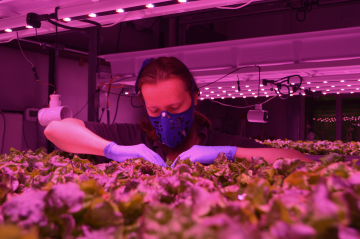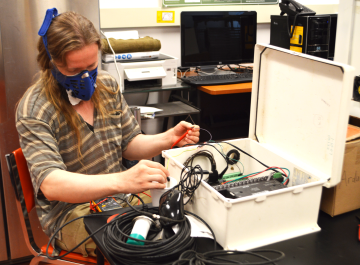Meet KC Shasteen.

Through the College of Agriculture and Life Sciences and the College of Engineering, KC is a Biosystems Engineering master's student with the University of Arizona's Controlled Environment Agriculture Center.
KC's previous academic experience has been in physics and mathematics, so he says that the Controlled Environment Agriculture (CEA) field is relatively new to him. KC first became interested in our program upon learning about ongoing projects in the UA-CEAC's Mars-Lunar Greenhouse and Vertical Farm.
"I am interested in CEA as a vital part of space exploration," KC said. "Long-term sustainable human presence off-world will require specially designed food production systems. These will likely be integrated into a larger system of atmosphere, water, and waste reprocessing in a Bioregenerative Life Support System (BLSS). An understanding of CEA is central to all of these processes."
With the mentoring of Dr. Murat Kacira, KC's research activities focus on developing plant response-based environmental control to enhance resource-use efficiency. His research is being conducted at the UA-CEAC's Vertical Farm facility, a system that has many similarities to one of a Bioregenerative Life Support System. Some of KC's research supports a multistate OptimIA project funded by USDA-SCRI.

Vertical farming is somewhat of a new technology compared to a typical CEA greenhouse structure. There are many benefits to vertical farming as well, some of which include fully controlled environments, reduced transport costs for produce, no chemicals or pesticide use, high water and resource efficiency, and higher yields achieved in a smaller growing footprint.
It also has great potential to be one of the leading solutions to fresh food scarcity in urban areas. With a rapidly growing population and changing climate conditions, the need for innovative food production technologies is becoming highly sought after.
But for vertical farming to become an accessible solution, a lot of research and work needs to be done. This is where people like KC come into play.
"The future of agriculture of any type will involve computer-aided decision support, and for that to happen, growers will need more and more frequent data in a format that is understandable to a computer system. Sensor and control systems need to be more user-friendly and interoperable, and new data management and processing firms will need to be created to help growers view, process, and manage data they have collected. If the industry can make this shift toward plug-and-play equipment and centralized data processing, I think it will have overcome one of the biggest hurdles to modernizing food production."
To continue the developments in that direction, KC has designed and implemented a camera sensor system for determining crop growth using computer vision. He now is evaluating that system, along with validating a predictive computer model for crop biomass growth, in an attempt to allow a computer to automatically control the environment of the vertical farm in a way that optimizes resource use and minimizes costs while still growing a high-quality product.

Aside from classes and research work for his graduate program, KC has been serving as the graduate student manager of the vertical farm here at UA-CEAC. His job is to ensure that equipment is operating as expected and act as an interface between researchers and the systems. Tasks can include sensor calibration, computer programming, and hardware maintenance and also collaboratively working with other fellow graduate and undergraduate student team members.
KC says that what is most important to him is learning what it takes to assemble and run a successful food production operation and gaining experience in the operation of the tools, chemicals, and sensors involved in the production process. In the future, KC aspires to help design a BLSS system and would welcome the opportunity to go to space or another planet and operate one in the field.
"My goal is to help design food production systems for orbital habitats and off-world bases. I want to see humanity move out into the rest of the solar system and, ultimately, to the stars beyond. Access to the resources of space is a solution to scarcity problems that a continuously growing world population will face, and in-situ food production is necessary to sustain human presence."
We have no doubt we will see KC exceed far BEYOND the horizons.

